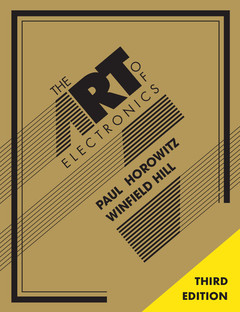Description
The Art of Electronics (3rd Ed., Revised edition)
Authors: Horowitz Paul, Hill Winfield
The new gold standard and indispensable reference for anyone, student or researcher, professional or amateur, who works with electronic circuits.
Language: English
Subject for The Art of Electronics:
Publication date: 03-2015
1220 p. · 21x26.2 cm · Hardback
1220 p. · 21x26.2 cm · Hardback
Description
/li>Contents
/li>Biography
/li>
At long last, here is the thoroughly revised and updated third edition of the hugely successful The Art of Electronics. It is widely accepted as the best single authoritative book on electronic circuit design, and is in fact so popular that it has been counterfeited - so beware if purchasing from a third party via an online retailer, as you may receive a very inferior physical product. In addition to new or enhanced coverage of many topics, the third edition includes 90 oscilloscope screenshots illustrating the behavior of working circuits, dozens of graphs giving highly useful measured data of the sort that is often buried or omitted in datasheets but which you need when designing circuits, and 80 tables (listing some 1650 active components), enabling intelligent choice of circuit components by listing essential characteristics (both specified and measured) of available parts. The new Art of Electronics retains the feeling of informality and easy access that helped make the earlier editions so successful and popular. It is an indispensable reference and the gold standard for anyone, student or researcher, professional or amateur, who works with electronic circuits.
1. Foundations; 2. Bipolar transistors; 3. Field effect transistors; 4. Operational amplifiers; 5. Precision circuits; 6. Filters; 7. Oscillators and timers; 8. Low noise techniques and transimpedance; 9. Power regulation; 10. Digital electronics; 11. Programmable logic devices; 12. Logical interfacing; 13. Digital meets analog; 14. Computers, controllers, and data links; 15. Microcontrollers.
Paul Horowitz is Professor of Physics at Harvard University, where he originated the Laboratory Electronics course in 1974, from which emerged The Art of Electronics. He was one of the pioneers of the search for intelligent life beyond the Earth, and one of the leaders behind SETI. Other research interests include observational astrophysics, x-ray and particle microscopy, and optical interferometry. He is the author of some 200 scientific articles and reports, has consulted widely for industry and government, and is the designer of numerous electronic and photographic instruments.
Winfield Hill has held positions at numerous organisations, including Harvard University's Electronic Design Center and Sea Data Corporation. Currently he is the Director of Electronics Engineering at the Rowland Institute for Science where he has designed some 250 electronic instruments. Recent interests include high-voltage RF (to 15kV) and precision high-current electronics (to 6000A).
Winfield Hill has held positions at numerous organisations, including Harvard University's Electronic Design Center and Sea Data Corporation. Currently he is the Director of Electronics Engineering at the Rowland Institute for Science where he has designed some 250 electronic instruments. Recent interests include high-voltage RF (to 15kV) and precision high-current electronics (to 6000A).
© 2024 LAVOISIER S.A.S.




